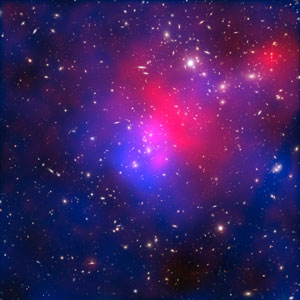Astronomers are peering into a galaxy cluster’s past, using Hubble’s Frontier Fields to measure the light from ghost stars cast adrift in galaxy collisions.
Imagine you’re on a faraway planet where night skies are bereft of the thousands of stars we’re accustomed to on Earth. Instead, skies are dark but for the hazy wisps of dozens or even hundreds of nearby galaxies.
That’s the night sky you might see if you're orbiting a ghost star, long since pulled free from its host galaxy during a galactic encounter. In a crowded cluster like Abell 2744, a galaxy has a good chance of experiencing a glancing collision, merger, or full-on disruption. Cast adrift in intergalactic space, the remnant stars emit a faint glow known as intracluster light, and until now, it has remained mostly a subject of theory.

NASA / ESA / J. Merten / D. Coe
The Hubble Space Telescope’s Frontier Fields, a multiyear undertaking to map six faraway galaxy clusters in exquisite detail, is changing that. The first to be imaged is Abell 2744, a cluster that had already earned the nickname Pandora’s Cluster for its violent past. It is the site of a near-simultaneous pile-up of four smaller clusters. Light from its hundreds of galaxies has traveled 3.5 billion years to reach Earth.
Now Mireia Montes and Ignacio Trujillo (University of La Laguna, Spain) have used Hubble’s long stare to construct visible-light and near-infrared color images of the cluster. They split these color images by brightness, so that they can examine the color not just of the luminous galaxies but also of the much fainter intracluster light.
“The authors say that the intracluster light is a not-well defined quantity, observationally speaking,” says theorist Emanuele Contini (University of Trieste, Italy). “I would say that observers do not have many other choices!” While theorists can track every star as they model a galaxy cluster’s evolution, observational astronomers must define intracluster light as any light below some threshold in surface brightness.
Given the incredibly faint threshold, few telescopes are capable of saying much about intracluster light other than that it exists. But in these Hubble observations, Montes and Trujillo can use the color of the cluster’s faintest glow to reveal the ghost stars’ age.
Compared to stars contained with the cluster’s galaxies, the ghost stars emit bluer light, implying a higher metal content. (Astronomers have an odd habit of defining metals as anything not hydrogen or helium. Generally, the more metals a star contains, the younger it is.) The ghost stars appear to be on average between 3 and 9 billion years younger than the stars within the cluster's galaxies, closer in age and metallicity to stars within a Milky Way-size galaxy.
When Montes and Trujillo calculate the total mass emitting the "ghost light", they find it's 6% or so of the cluster’s total stellar mass. In other words, more than a hundred billion Suns’ worth of stars are floating around between the cluster’s galaxies.
Knowing the mass and age of the cluster's ghost light, the authors propose a simplest-case scenario: sometime relatively recently in this cluster’s history, violent collisions tore apart between four and six Milky Way-size galaxies, scattering their stars into intergalactic space. Contini notes that this is undoubtedly a lower limit, since any given galaxy collision is more likely to strip some stars rather than utterly destroy the galaxy.
Montes and Trujillo plan similar studies to piece together the collision history for the Fronter Fields’ other five galaxy clusters. The duo will also expand their study of Abell 2744 to include Hubble’s ultraviolet observations, which can pin down the ghost stars’ ages with even higher precision, a step theorists and observational astronomers alike agree is necessary to understanding galaxy clusters’ violent pasts.
References
M. Montes & I. Trujillo. "Intracluster Light at the Frontier: A2744." Astrophysical Journal. October 20, 2014.
Learn more about what the Frontier Fields have in store for us in our January 2015 issue - subscribe now!
 1
1









Comments
justme632000
February 5, 2017 at 1:28 am
I'm 76 but just getting into this amazing field, but WOW, it is unreal
You must be logged in to post a comment.
You must be logged in to post a comment.